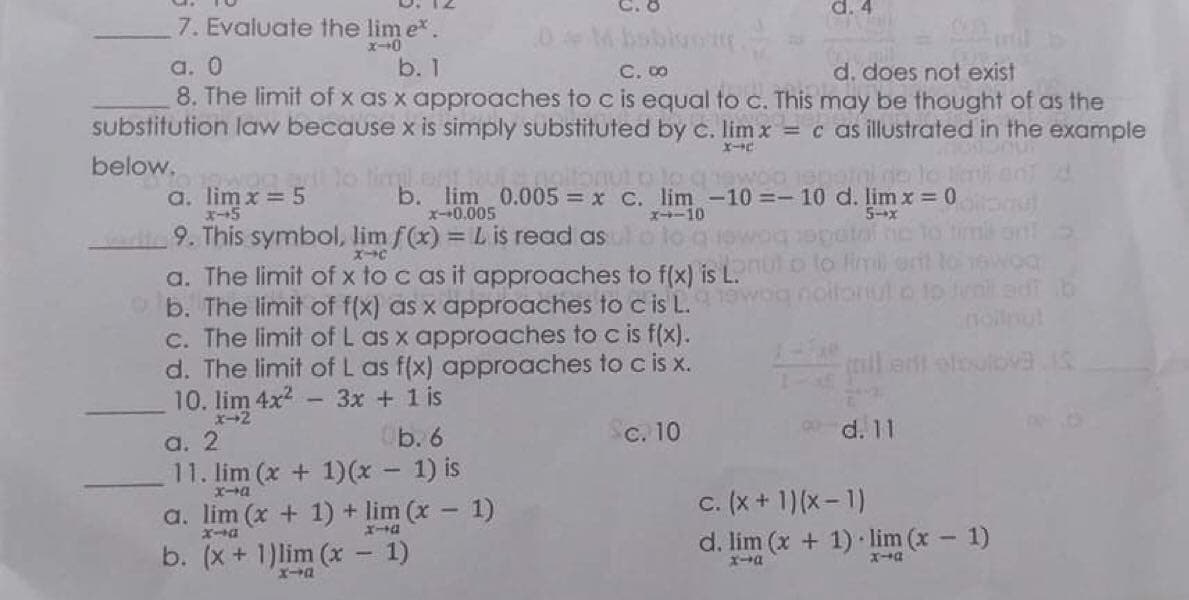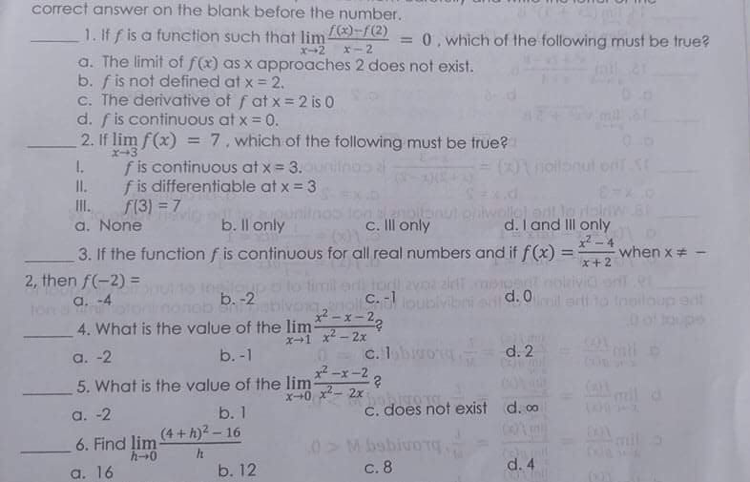C.O d. 7. Evaluate the lim e. x-0 0M bobivo a. 0 8. The limit of x as x approaches to c is equal to c. This may be thought of as th- titution law because x is simply substituted by c. lim x = c as illustrated in the exa b. 1 C. 00 d. does not exist %3D w. a. lim x = 5 b. lim 0.005 = x C. lim -10 - 10 d. lim x = 0 X-10 X-5 9. This symbol, lim f(x) L is read as a. The limit of x to c as it approaches to f(x) is L. b. The limit of f(x) as x approaches to c is L. c. The limit of L as x approaches to c is f(x). d. The limit of L as f(x) approaches to c is x. 10. lim 4x2 x0.005 5-x o lo q 1ow olo limi orllo noilorul o to adi b rill er oloulovas 3x + 1 is x+2 a. 2 b. 6 Sc. 10 d. 11 11. lim (x + 1)(x 1) is c. (x + 1) (x- 1) d. lim (x + 1) lim (x 1) x-a a. lim (x + 1) + lim (x 1) エートは b. (x + 1)lim (x - 1)
C.O d. 7. Evaluate the lim e. x-0 0M bobivo a. 0 8. The limit of x as x approaches to c is equal to c. This may be thought of as th- titution law because x is simply substituted by c. lim x = c as illustrated in the exa b. 1 C. 00 d. does not exist %3D w. a. lim x = 5 b. lim 0.005 = x C. lim -10 - 10 d. lim x = 0 X-10 X-5 9. This symbol, lim f(x) L is read as a. The limit of x to c as it approaches to f(x) is L. b. The limit of f(x) as x approaches to c is L. c. The limit of L as x approaches to c is f(x). d. The limit of L as f(x) approaches to c is x. 10. lim 4x2 x0.005 5-x o lo q 1ow olo limi orllo noilorul o to adi b rill er oloulovas 3x + 1 is x+2 a. 2 b. 6 Sc. 10 d. 11 11. lim (x + 1)(x 1) is c. (x + 1) (x- 1) d. lim (x + 1) lim (x 1) x-a a. lim (x + 1) + lim (x 1) エートは b. (x + 1)lim (x - 1)
Calculus: Early Transcendentals
8th Edition
ISBN:9781285741550
Author:James Stewart
Publisher:James Stewart
Chapter1: Functions And Models
Section: Chapter Questions
Problem 1RCC: (a) What is a function? What are its domain and range? (b) What is the graph of a function? (c) How...
Related questions
Question

Transcribed Image Text:d. 4
7. Evaluate the lim e.
x-+0
а. 0
b. T
C. 00
8. The limit of x as x approaches to c is equal to c. This may be thought of as the
substitution law because x is simply substituted by c. lim x = c as illustrated in the example
d. does not exist
below.
Olde le
a. lim x = 5
b. lim 0.005 = x C. lim -10 - 10 d. lim x 0
ズーー10
x0.005
5-x
9. This symbol, lim f(x) L is read aso to a
a. The limit of x to c as it approaches to f(x) is L.
b. The limit of f(x) as x approaches to c is L.
c. The limit of L as x approaches to c is f(x).
d. The limit of L as f(x) approaches to c is x.
3x + 1 is
ズ→C
to fimi ont
noltorul o to onladi b
(rill ert oloulovas
10. lim 4x2
Ob. 6
c. 10
d. 11
a. 2
11. lim (x + 1)(x 1) is
a. lim (x + 1) + lim (x - 1)
b. (x + 1)lim (x - 1)
エーa
c. (x + 1) (x- 1)
d. lim (x + 1) lim (x 1)

Transcribed Image Text:correct answer on the blank before the number.
1. If f is a function such that lim )-f(2)
a. The limit of f(x) as x approaches 2 does not exist.
b. f is not defined at x = 2.
c. The derivative of f at x = 2 is 0
d. f is continUOus at x = 0.
2. If lim f(x) = 7, which of the following must be true?
0, which of the following must be true?
%3D
X-2
x-2
%3D
X+3
f is continuous at x = 3.
II.
1.
(2noilonut on SE
f is differentiable at x = 3
f(3) = 7
a. None
II.
c. II only
wollo ent Ja rlairw.
d. I and II only
b. Il only
2-4
%3D
3. If the function f is continuous for all real numbers and if f(x) =
when x # -
2, then f(-2) =
mil er todlavo alt
a. -4
b. -2
d. 0
loup adt
2-x-22
4. What is the value of the lim
x-1 x- 2x
a. -2
b. -1
c.1bwo
d. 2
x2 -x-2
5. What is the value of the lim
X+0
-2x
mil a
b. 1
C. does not exist d. o
a. -2
(4 +h)2 – 16
6. Find lim
h0
0>M bsbivorg
c. 8
d. 4
a. 16
b. 12
Expert Solution
This question has been solved!
Explore an expertly crafted, step-by-step solution for a thorough understanding of key concepts.
This is a popular solution!
Trending now
This is a popular solution!
Step by step
Solved in 2 steps

Recommended textbooks for you

Calculus: Early Transcendentals
Calculus
ISBN:
9781285741550
Author:
James Stewart
Publisher:
Cengage Learning

Thomas' Calculus (14th Edition)
Calculus
ISBN:
9780134438986
Author:
Joel R. Hass, Christopher E. Heil, Maurice D. Weir
Publisher:
PEARSON

Calculus: Early Transcendentals (3rd Edition)
Calculus
ISBN:
9780134763644
Author:
William L. Briggs, Lyle Cochran, Bernard Gillett, Eric Schulz
Publisher:
PEARSON

Calculus: Early Transcendentals
Calculus
ISBN:
9781285741550
Author:
James Stewart
Publisher:
Cengage Learning

Thomas' Calculus (14th Edition)
Calculus
ISBN:
9780134438986
Author:
Joel R. Hass, Christopher E. Heil, Maurice D. Weir
Publisher:
PEARSON

Calculus: Early Transcendentals (3rd Edition)
Calculus
ISBN:
9780134763644
Author:
William L. Briggs, Lyle Cochran, Bernard Gillett, Eric Schulz
Publisher:
PEARSON

Calculus: Early Transcendentals
Calculus
ISBN:
9781319050740
Author:
Jon Rogawski, Colin Adams, Robert Franzosa
Publisher:
W. H. Freeman


Calculus: Early Transcendental Functions
Calculus
ISBN:
9781337552516
Author:
Ron Larson, Bruce H. Edwards
Publisher:
Cengage Learning